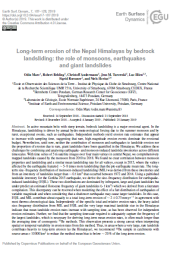Long-term erosion of the Nepal Himalayas by bedrock land sliding: the role of monsoons, earthquakes and giant landslides
Summary
This study paper discusses the role of landslides as a significant erosional agent in active mountain belts with steep terrain, specifically focusing on the Himalayas. It mentions that land sliding in the Himalayas is primarily driven by the annual hydro-meteorological forcing of the summer monsoon and rarer, exceptional events such as earthquakes. The erosion rate estimates obtained from independent methods suggest that rare, high-magnitude erosion events have a dominant influence on the overall erosions. To address the lack of quantification regarding the contributions of the monsoon and earthquakes to landslide erosion in the Himalayas, the authors of the study combined and analyzed earthquake- and monsoon-induced landslide inventories over different timescales.
The findings did not show a clear correlation between monsoon properties and land sliding, and the mean land sliding rate was similar for all valleys, except in 2015 when the earthquake significantly increased land sliding in the affected valleys by approximately 5-8 times compared to the pre-earthquake mean rate.
Categories:
Journal
Publisher:
Earth Surface Dynamics
Published Year:
2019
